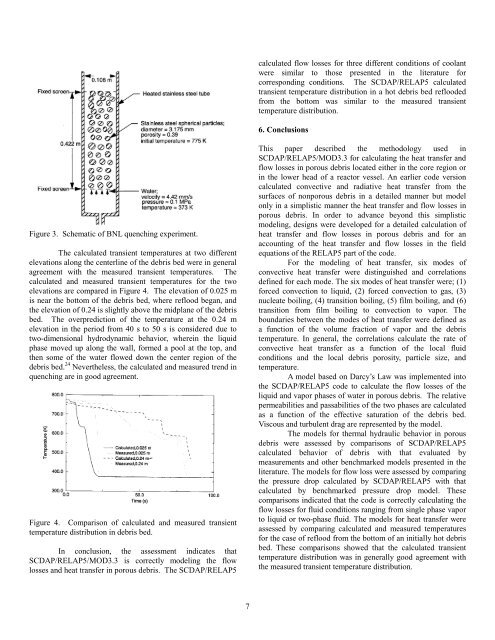SCDAP/RELAP5 Modeling of Fluid Heat Transfer and Flow Losses ...
SCDAP/RELAP5 Modeling of Fluid Heat Transfer and Flow Losses ...
SCDAP/RELAP5 Modeling of Fluid Heat Transfer and Flow Losses ...
Create successful ePaper yourself
Turn your PDF publications into a flip-book with our unique Google optimized e-Paper software.
calculated flow losses for three different conditions <strong>of</strong> coolant<br />
were similar to those presented in the literature for<br />
corresponding conditions. The <strong>SCDAP</strong>/<strong>RELAP5</strong> calculated<br />
transient temperature distribution in a hot debris bed reflooded<br />
from the bottom was similar to the measured transient<br />
temperature distribution.<br />
6. Conclusions<br />
Figure 3. Schematic <strong>of</strong> BNL quenching experiment.<br />
The calculated transient temperatures at two different<br />
elevations along the centerline <strong>of</strong> the debris bed were in general<br />
agreement with the measured transient temperatures. The<br />
calculated <strong>and</strong> measured transient temperatures for the two<br />
elevations are compared in Figure 4. The elevation <strong>of</strong> 0.025 m<br />
is near the bottom <strong>of</strong> the debris bed, where reflood began, <strong>and</strong><br />
the elevation <strong>of</strong> 0.24 is slightly above the midplane <strong>of</strong> the debris<br />
bed. The overprediction <strong>of</strong> the temperature at the 0.24 m<br />
elevation in the period from 40 s to 50 s is considered due to<br />
two-dimensional hydrodynamic behavior, wherein the liquid<br />
phase moved up along the wall, formed a pool at the top, <strong>and</strong><br />
then some <strong>of</strong> the water flowed down the center region <strong>of</strong> the<br />
debris bed. 24 Nevertheless, the calculated <strong>and</strong> measured trend in<br />
quenching are in good agreement.<br />
Figure 4. Comparison <strong>of</strong> calculated <strong>and</strong> measured transient<br />
temperature distribution in debris bed.<br />
In conclusion, the assessment indicates that<br />
<strong>SCDAP</strong>/<strong>RELAP5</strong>/MOD3.3 is correctly modeling the flow<br />
losses <strong>and</strong> heat transfer in porous debris. The <strong>SCDAP</strong>/<strong>RELAP5</strong><br />
This paper described the methodology used in<br />
<strong>SCDAP</strong>/<strong>RELAP5</strong>/MOD3.3 for calculating the heat transfer <strong>and</strong><br />
flow losses in porous debris located either in the core region or<br />
in the lower head <strong>of</strong> a reactor vessel. An earlier code version<br />
calculated convective <strong>and</strong> radiative heat transfer from the<br />
surfaces <strong>of</strong> nonporous debris in a detailed manner but model<br />
only in a simplistic manner the heat transfer <strong>and</strong> flow losses in<br />
porous debris. In order to advance beyond this simplistic<br />
modeling, designs were developed for a detailed calculation <strong>of</strong><br />
heat transfer <strong>and</strong> flow losses in porous debris <strong>and</strong> for an<br />
accounting <strong>of</strong> the heat transfer <strong>and</strong> flow losses in the field<br />
equations <strong>of</strong> the <strong>RELAP5</strong> part <strong>of</strong> the code.<br />
For the modeling <strong>of</strong> heat transfer, six modes <strong>of</strong><br />
convective heat transfer were distinguished <strong>and</strong> correlations<br />
defined for each mode. The six modes <strong>of</strong> heat transfer were; (1)<br />
forced convection to liquid, (2) forced convection to gas, (3)<br />
nucleate boiling, (4) transition boiling, (5) film boiling, <strong>and</strong> (6)<br />
transition from film boiling to convection to vapor. The<br />
boundaries between the modes <strong>of</strong> heat transfer were defined as<br />
a function <strong>of</strong> the volume fraction <strong>of</strong> vapor <strong>and</strong> the debris<br />
temperature. In general, the correlations calculate the rate <strong>of</strong><br />
convective heat transfer as a function <strong>of</strong> the local fluid<br />
conditions <strong>and</strong> the local debris porosity, particle size, <strong>and</strong><br />
temperature.<br />
A model based on Darcy’s Law was implemented into<br />
the <strong>SCDAP</strong>/<strong>RELAP5</strong> code to calculate the flow losses <strong>of</strong> the<br />
liquid <strong>and</strong> vapor phases <strong>of</strong> water in porous debris. The relative<br />
permeabilities <strong>and</strong> passabilities <strong>of</strong> the two phases are calculated<br />
as a function <strong>of</strong> the effective saturation <strong>of</strong> the debris bed.<br />
Viscous <strong>and</strong> turbulent drag are represented by the model.<br />
The models for thermal hydraulic behavior in porous<br />
debris were assessed by comparisons <strong>of</strong> <strong>SCDAP</strong>/<strong>RELAP5</strong><br />
calculated behavior <strong>of</strong> debris with that evaluated by<br />
measurements <strong>and</strong> other benchmarked models presented in the<br />
literature. The models for flow loss were assessed by comparing<br />
the pressure drop calculated by <strong>SCDAP</strong>/<strong>RELAP5</strong> with that<br />
calculated by benchmarked pressure drop model. These<br />
comparisons indicated that the code is correctly calculating the<br />
flow losses for fluid conditions ranging from single phase vapor<br />
to liquid or two-phase fluid. The models for heat transfer were<br />
assessed by comparing calculated <strong>and</strong> measured temperatures<br />
for the case <strong>of</strong> reflood from the bottom <strong>of</strong> an initially hot debris<br />
bed. These comparisons showed that the calculated transient<br />
temperature distribution was in generally good agreement with<br />
the measured transient temperature distribution.<br />
7

















